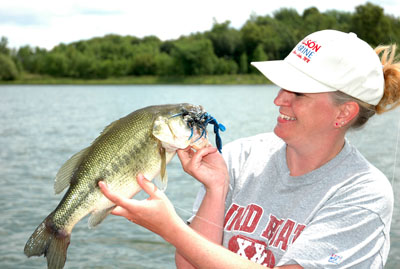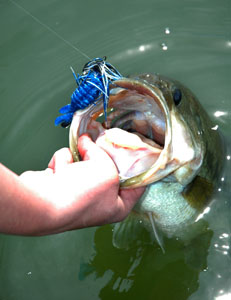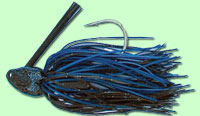
Scott Petersen |
Looking
through my tackle box when I got to the lake I was trying
to decide what I should start with, after a few minutes
I decided to tie on and throw a jig. I do not care what
conditions you are faced with you cannot go wrong when you
are fishing a jig for bass. Let’s
talk about 5 ways to fish a jig for bass throughout the
season.
Swim Jigs
Swim Jigs have been one of the top choices the last few years
when it comes to jigs and bass fishing. What started as
an accident has now turned out to be a great tactic to give
bass a different look at jigs and how they are fished. How
many times has this happened to you? You make a cast that
falls short of your target so instead of fishing the jig
back to the boat you start to reel the jig right back to
the boat. As the jig gets closer to the boat you see a bass
follow the jig your first instinct is to stop the jig and
when you do that the bass stops, turns and swims away. After
seeing this a few times some pros got the idea to fish the
jig all the way back to the boat this way and to their surprise
they started to trigger strikes and catch bass. Thus the
swim jig tactic was born. What started out as a regular
bass jig has now changed to a specialty swim jigs that are
on the market, my choice for this tactic is to use an Outkast
Swim Jig.
Simply
put if you can fish a spinnerbait you can fish a swim jig
in fact I many times will give new fishermen a swim jig
instead of a spinnerbait now because the swim jig at times
is more fishable than a spinnerbait. To fish a swim jig
is simple you make your cast and start to reel the jig back
to the boat. When reeling do not try to impart any action
into the jig just let the jig do it’s thing,
I have seen bass get turned off by a jig that has too much
action you just simply want to cast and reel.
 How fast
you reel will have to do with the jig size you are using
and how deep you need to get your swim jig down to. For
the majority of my swim jig fishing I use either 1/4oz or
3/8oz jigs. One of the keys to getting more bass to strike
your swim jig is the trailer that you use, the majority
of the time I use a 5” Outkast Fat
Tail Grub but keep your options open and experiment. Plastic
chunks, Naughty Bugs and even double tail grubs are all
great options to try from time to time. Play with different
trailers and see how they affect your jig and the bass;
you will soon learn what trailer to use for the conditions
you are fishing.
How fast
you reel will have to do with the jig size you are using
and how deep you need to get your swim jig down to. For
the majority of my swim jig fishing I use either 1/4oz or
3/8oz jigs. One of the keys to getting more bass to strike
your swim jig is the trailer that you use, the majority
of the time I use a 5” Outkast Fat
Tail Grub but keep your options open and experiment. Plastic
chunks, Naughty Bugs and even double tail grubs are all
great options to try from time to time. Play with different
trailers and see how they affect your jig and the bass;
you will soon learn what trailer to use for the conditions
you are fishing.
For fishing purposes with the swim jig I use a 7ft medium
action baitcaster, teamed with a matching baitcaster spooled
with 12lb to 17lb fluorocarbon line. The lower stretch factor
of fluorocarbon line helps me get a better hook set when bass
are on the move and hitting light. When you set the hook you
need to use a sweep set, if you try to set the hook by raising
your rod over your head you will miss more bass than you will
catch.
Jig Worm
As the summer months go on bass will start to take up residence
in deeper water on the outside weedline edges or may move
even deeper to off shore humps. When this happens you cannot
beat a jig worm presentation when the bite is tough. You
will find there will be times when you have to go to the
finesse side of the coin to get bites and when this happens
you cannot beat a jig worm presentation.
 4” and 6” worms
will be the choice when it comes to plastics for a start
and when you are talking jig I use an Outkast Money Jig.
The sizes I use and carry are mainly 1/16oz, 1/8oz and 3/16oz.
When faced with cold front conditions bass will slow down
and you have to follow by going to smaller baits to get
bites.
4” and 6” worms
will be the choice when it comes to plastics for a start
and when you are talking jig I use an Outkast Money Jig.
The sizes I use and carry are mainly 1/16oz, 1/8oz and 3/16oz.
When faced with cold front conditions bass will slow down
and you have to follow by going to smaller baits to get
bites.
To fish the Money Jig presentation I use a 7ft spinning medium
action rod teamed up with a spinning reel, spooled with either
6lb or 8lb mono or fluorocarbon line. Special note here the
lighter the line the more bites you will get; my rule of thumb
is if I am fishing on the weed edge I use 8lb test line. This
allows me a few extra pounds in line size in case the bass
get into the weeds. If I am fishing in the open water I will
opt for 6lb line. I feel I get more bites using the smaller
line and bass do not have anything to get hung up on.
Touchdown Jig
If you are looking for bass that are located on off shore
rocks you cannot beat using an Outkast Touchdown Jig. The
1/2oz and 3/4oz Touchdown Jigs allow you to explore the
bottom as you fish making sure you are spending key time
on the prime structure that will hold the biggest bass of
the spot. When fishing the Touchdown Jig I have two main
ways that I rig the bait. For one I rig the jig in a traditional
way with an Outkast Spider Grub, but when I want a different
look I will add a Hitch Hiker and thread on a craw. When
rigging the jig this way I get a great craw imitation that
gets bites when the regular spider grub rigged Touchdown
will not.
 The key to fishing a Touchdown Jig is the retrieve you do
not hop the jig along the bottom like you would when fishing
a traditional jig you drag the jig along the bottom. That
is what translates to you the bottom makeup. When you get
your Touchdown Jig next to a rock try to rock it back and
forth a few times before you move the jig onto the next rock,
this action is what will get you more strikes by the end of
your day of fishing.
The key to fishing a Touchdown Jig is the retrieve you do
not hop the jig along the bottom like you would when fishing
a traditional jig you drag the jig along the bottom. That
is what translates to you the bottom makeup. When you get
your Touchdown Jig next to a rock try to rock it back and
forth a few times before you move the jig onto the next rock,
this action is what will get you more strikes by the end of
your day of fishing.
When it comes to fishing the Touchdown Jig I use either a
7ft heavy action baitcaster rod or a 7 1/2ft flipping stick.
Either rod is teamed with a matching reel that is spooled
with 15lb to 20lb fluorocarbon line.
Snap and Pop
When bass move out onto the flats during post spawn they will
start to take up summer residence. Some bass will stay shallow
while others will make movements towards the deeper weedline
and clumps located outside of the weedline edge. When these
bass get active they will station themselves on the tops
of the weed edges and feed as food passes by but when they
get in a mood they will bury up in the weeds and get down
to the bottom edge of the weeds and wait for food to pass
by. If it is close enough you may get a reaction but if
it is not, you will play like heck to get their attention
and a bite. To appeal to this reaction mood you need something
that will get a reaction from the bass; for that I turn
to the Outkast RT Jig and fish a little snap and pop tactic.
This is not fishing for the faint hearted this is power bass
fishing all the way. I use either 1/2oz or 3/4oz jigs for
this tactic. Make your casts short and let the RT Jig fall
to the bottom. Once the jig hits the bottom give the rod a
good snap this will pop the jig off of the bottom and out
of the weeds. Let the jig settle back to the bottom and try
again.
With the jig hopping out of the weeds this is generally when
you will get the reaction bite out of the bass, so pay special
attention when you go to move the jig again. When it comes
to equipment this is power fishing all the way. 7ft heavy
action to 7 1/2ft flipping sticks teamed with high retrieve
reels to take up slack line quickly to set the hook and spooled
with 20lb to 30lb fluorocarbon line.
 Flippin and Pitching
Flippin and Pitching
During the summer month’s bass will react to cold fronts
by burying up in cover and when that happens from time to
time you may have to go in and get them, during these conditions
you cannot beat flippin and pitching. When it comes to flipping
I match the jig to the cover that I have to fish. Here you
have to cover all your bases I carry all sizes of the Outkast
RT Jig in my box. There will be days when you have to finesse
flip jigs to get critical bites then there will be days when
you have to power your jig through the cover to even get your
bait into the bass zone.
For flipping and pitching I use a 7 1/2ft flippin stick,
matched with a baitcasting reel and spooled with 20lb to 30lb
fluorocarbon line. The reason for the use of fluorocarbon
instead of braid is water clarity factors. If I am fishing
in clear water conditions I opt to use fluorocarbon line if
the water clarity is low I will use braid if conditions call
for it.
So as you can see anytime is jig time for bass, in fact you
can say there is not a bad time to throw a jig for bass. When
fishing for bass my motto is grab and fish a jig, you cannot
go wrong. Give these jig tactics a try this season you will
see what I mean; you cannot go wrong with a jig.
Create
some memories please remember to practice CPR (Catch, Photo
and Release). The future of fishing is in your hands. For
more timely bass tips and tactics please log onto www.fishinginsider.com
If you would
like to read more from Scott Petersen, visit his web site Fishing
Insider

